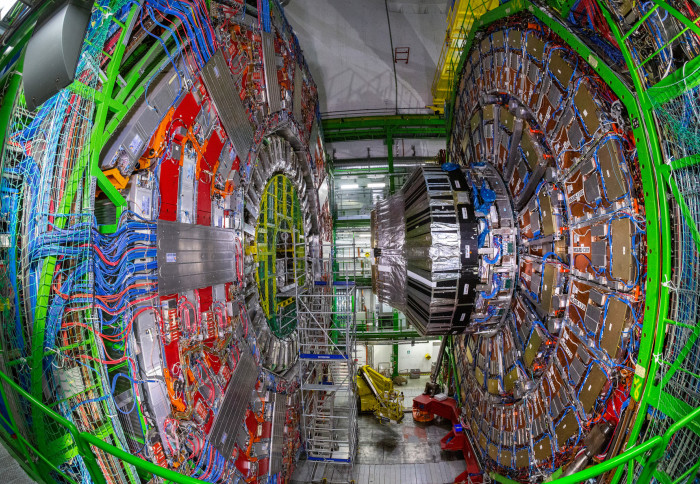Imperial receives £7.64m to keep UK at the forefront of particle physics

The CMS experiment at CERN
Imperial has received funding from the STFC to continue investigating the properties of elementary particles and the fundamental forces of nature.
The Science and Technology Facilities Council (STFC) is investing £60 million as part of its continued support to the particle physics research community in the UK. Among 18 universities receiving funding, Imperial takes the largest chunk.
It is wonderful to see recognition of Imperial’s major role across such a broad programme and range of activities. Professor Gavin Davies
Particle physics studies the world at the smallest possible distance scales and the highest achievable energies, seeking answers to fundamental questions about the structure of matter and the composition of the Universe.
Professor Gavin Davies, Imperial group leader, said: “It is wonderful to see recognition of Imperial’s major role across such a broad programme and range of activities. This grant will allow us to continue our leading research in a range of areas of fundamental and applied science.”
Professor Grahame Blair, STFC Executive Director for Programmes, said: “The grants are vital in supporting technicians, engineers and academics in their skills and expertise in the field, all while encouraging career development in fundamental research with both universities and international collaborators."
Imperial physicists were recognised by the grants panel as having an internationally leading reputation for both detector development and operations, as well as data analysis. Researchers from the College are involved in several key experiments around the world.
The Large Hadron Collider
Imperial physicists work on two experiments based at the Large Hadron Collider at CERN, where the Higgs boson was discovered in 2012. The Compact Muon Solenoid (CMS) experiment will continue to characterise the Higgs boson and provide a unique window onto new physics effects.

Measurements at the LHCb experiment, led by the group, have revealed deviations from the ‘Standard Model’ of physics, potentially indicating a new phenomenon known as lepton non-universality. Investigating this situation is a high priority for the group.
Imperial researchers working at the LHC will also continue preparing the next generation of CMS and LHCb detectors for the high luminosity upgrade of the LHC.
Neutrino experiments
The Tokai to Kamioka (T2K) experiment, based in Japan, fires neutrinos 295km through the Earth to measure how they change as they travel. Experiments here have shown strong evidence of neutrinos and antineutrinos acting differently, suggesting a possible answer to the question of why there is more matter than antimatter in the Universe.

To fully characterise this potential difference and its role in the observed matter-antimatter asymmetry requires the next generation detectors – DUNE in the US and Hyper-K in Japan – in which Imperial are also involved.
Neutrinos have thrown up other questions, such as anomalies that show up when neutrinos travel only very short distances, and whether the neutrino is its own antiparticle. The SoLid and SuperNEMO experiments will help address these questions. Heavy neutrino-like particles are predicted in several new physics models and the Imperial group are conducting research and development towards the SHiP experiment to search for these new particles.
Searching for dark matter

Around a quarter of the Universe is composed of dark matter and its nature is unknown. This has so far remained undetected in the laboratory and the Imperial group will continue its activity in searching for direct evidence of a dark matter candidate through the LUX-ZEPLIN experiment, along with preparations for the next-generation detector.
They are also key partners in the new Atom Interferometry Observatory and Network (AION) that will use quantum technologies to probe for ultra-light dark matter and, in time, gravitational waves.
Muons and beyond
The Standard Model of physics leaves little room for the conversion of particles called muons into electrons, so any observation of this process would be a major discovery. The COMET experiment is searching for this process and will take data during the grant.
Similarly, a measurable ‘electric dipole moment’ for the electron – the separation of positive and negative electrical charges – could only arise through new physics and the eEDM experiment will continue to define the boundaries of such an effect.
Accelerators to produce muon beams will be needed for future neutrino and muon collider experiments. The group is continuing its research in this area through the nuSTORM studies. Proton beams also have potential applications for other scientific fields and for healthcare, in particular cancer treatment, and the group is studying how to apply these techniques in those areas.

Much of the analysis carried out in the group involves very large data sets, advanced statistical procedures and machine learning – techniques with ever greater importance in a wider context. The group continues to apply such approaches, along with aspects of its instrumentation programme, to wider societal issues.
Article supporters
Article text (excluding photos or graphics) © Imperial College London.
Photos and graphics subject to third party copyright used with permission or © Imperial College London.
Reporter
Hayley Dunning
Communications Division